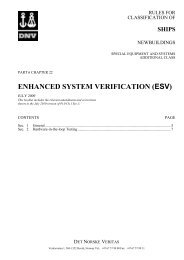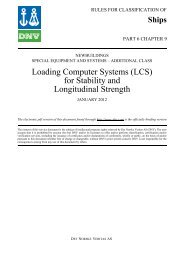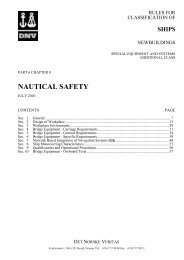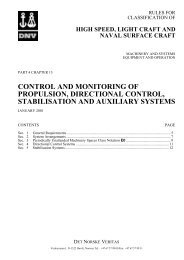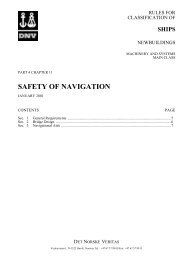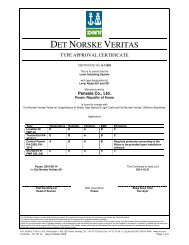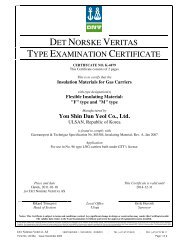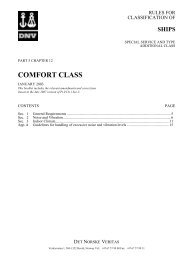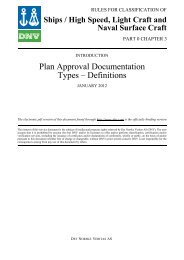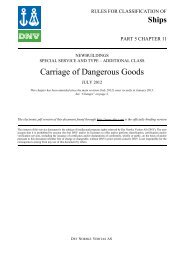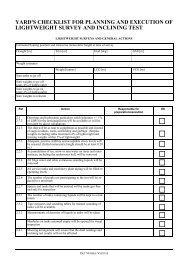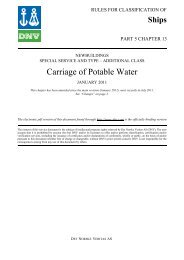Ship rules Pt.5 Ch.11 - Carriage of Dangerous Goods - DNV Exchange
Ship rules Pt.5 Ch.11 - Carriage of Dangerous Goods - DNV Exchange
Ship rules Pt.5 Ch.11 - Carriage of Dangerous Goods - DNV Exchange
You also want an ePaper? Increase the reach of your titles
YUMPU automatically turns print PDFs into web optimized ePapers that Google loves.
DET NORSKE VERITAS AS<br />
Rules for <strong>Ship</strong>s, July 2012<br />
<strong>Pt.5</strong> <strong>Ch.11</strong> Sec.2 – Page 14<br />
B 1000 Self unloading systems for solid bulk cargoes<br />
1001 Types <strong>of</strong> self unloading systems:<br />
Closed: The part <strong>of</strong> the system located outside the cargo hold is fully enclosed, e.g. pneumatic systems or fully<br />
enclosed chain conveyors.<br />
Open: Open type systems, e.g. belt conveyors and bucket conveyors.<br />
1002 For some cargoes the use <strong>of</strong> self unloading systems are not permitted due to hazards involved. For other<br />
cargoes only closed systems are permitted. Restrictions on use <strong>of</strong> self unloading systems are shown in Table<br />
D1.<br />
1003 Enclosed spaces containing self unloading systems shall be provided with a water flushing system<br />
enabling easy cleaning/removal <strong>of</strong> dust deposits.<br />
1004 Self unloading systems <strong>of</strong> the open type shall be arranged for emergency stop from convenient locations<br />
within the cargo handling spaces and on open deck.<br />
1005 Spaces outside cargo holds containing self unloading systems shall be fitted with mechanical<br />
ventilation giving at least 6 air changes per hour.<br />
1006 Conveyor belts shall be made from materials not liable to accumulate static electricity.<br />
B 1100 Special requirements<br />
1101 Gas measuring instruments<br />
When transporting a bulk cargo which is liable to emit a toxic or flammable gas, or cause oxygen depletion in<br />
the cargo space, the ship shall be provided with gas measuring instruments as follows:<br />
a) Instruments for measuring hydrogen gas or methane gas (0-100% LEL).<br />
b) Instruments for measuring toxic gases that may be given <strong>of</strong>f from the particular cargo.<br />
c) Instruments for measuring oxygen concentration (0-21% by volume).<br />
(SOLAS Reg. VI/3.1)<br />
The instruments may be portable or fixed.<br />
In case portable gas measuring instruments are provided, suitable sampling connections enabling the checking<br />
<strong>of</strong> atmosphere in holds and cargo handling spaces without need <strong>of</strong> entry, shall be arranged.<br />
(IMSBC Code, App. 6)<br />
Guidance note:<br />
Sampling points for cargo holds should be located as high as possible, e.g. upper part <strong>of</strong> hatch coaming. In order to<br />
ensure safe access in adverse weather conditions, two sampling points per hold should be provided, preferably one on<br />
each side. Fore and aft location may also be accepted if this is deemed more advantageous.<br />
Sampling openings must be fitted with means <strong>of</strong> closure, e.g. threaded plug or cap, ball valve or similar. Appendix 6<br />
<strong>of</strong> the IMSBC Code gives guidance on arrangements and procedures for gas sampling.<br />
---e-n-d---<strong>of</strong>---G-u-i-d-a-n-c-e---n-o-t-e---<br />
1102 Temperature detection in cargo holds<br />
Cargo holds shall be fitted with arrangements for detecting temperatures in the cargo.<br />
The temperature sensors shall be either permanently fitted or <strong>of</strong> portable type. If portable sensors are used the<br />
arrangement shall enable measurement <strong>of</strong> the temperature <strong>of</strong> the cargo without entry <strong>of</strong> the hold being<br />
necessary.<br />
1103 Inerting <strong>of</strong> cargo holds<br />
Cargo holds shall be provided with arrangements for maintaining an inert atmosphere in the loaded hold.<br />
Oxygen content is not to exceed 5% by volume. The arrangement is to enable purging <strong>of</strong> the space above the<br />
cargo with inert gas.<br />
1104 Separation <strong>of</strong> cargo holds from oil tanks<br />
Cargo holds are not to have tanks intended for fuel oil and/or lubricating oil located adjacently unless 1106 is<br />
complied with.<br />
1105 Separation <strong>of</strong> cargo from heated surfaces<br />
Heated oil tanks; double bottom tanks, top wing tanks, deep tanks, hopper tanks, side tanks, etc., adjacent to<br />
cargo holds, shall be fitted with permanent temperature indicators or provided with a suitable arrangement for<br />
using portable indicators. Temperature limits as specified in the IMSBC Code shall not be exceeded.



